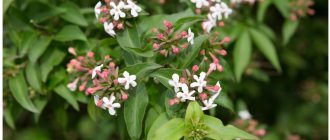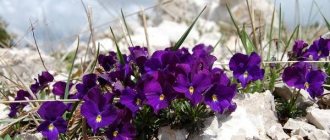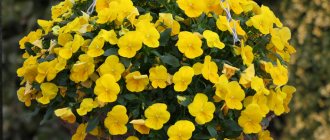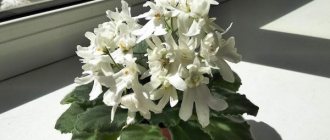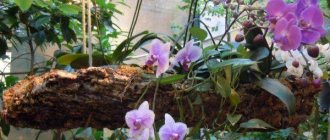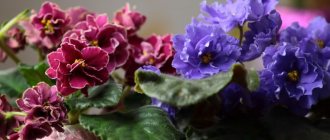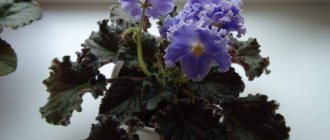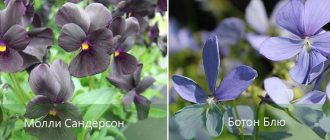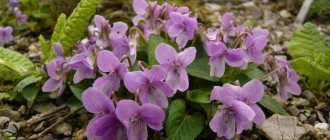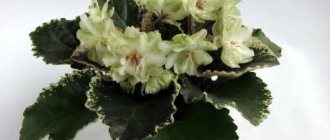Indoor violet (Saintpaulia) is a genus of flowering plants widely represented in home floriculture and belongs to the Gesneriev family. Homeland - Uzambara Mountains. The distribution area is in the regions of East Africa, with a humid and warm climate. Another name is African violet.
This flower is called the Usambara violet because of its resemblance to the true violu, but in fact it is far from these plants of the violet family, which grow in temperate climates.
Description of Saintpaulia
The genus is represented by low-growing evergreen perennial herbaceous bushes.
They have an underdeveloped fibrous root system, fleshy stems, and leaves tightly collected in a rosette at the roots. These are their general characteristics, but otherwise the species are very diverse. Differ:
- Flowers: shape - bordered (pansy), fancy, classic star-shaped, chimera; petals - simple (5 petals), comb (in addition to 5 simple ones there are additional underdeveloped ones), semi-double (7-8), double (more than 10), carnations (more than 10, but larger); single-color, multi-color.
- Leaves: shape - round, oval, elongated, with smooth or serrated edges; color - from dark green to light green, plain and variegated.
- Rosette: micromini (diameter 8 cm), mini (12-15 cm), semi-mini (less than 20 cm), standard (20 to 40 cm).
Types of Saintpaulia (African violet)
Varieties are divided into types according to their distinctive characteristics:
| Type according to flower shape Petal feature | Variety | Leaves | Flowers |
| Pansies Five-petalled. Two small ones and three larger ones. | Lions Pirates Treasures | Burgundy oval with a bubble structure. | Bright pink, along the edge there is a wide crimson stripe like a fringe. |
| Cinderella's dream | Dark green wavy. | Light purple with red-violet ruffled border. The upper petals are smaller and darker. | |
| Melody Kimi | Herbaceous in the shape of a heart. | Simple white, the top two petals are blue, the rest are lightly powdered with this color along the edges. | |
| Star Identical, spaced evenly around the center. | Kev's Heavenly Star | Simple oval pointed. Green, with a red back. | Regular and semi-double pink, fuchsia edge. |
| Goddess of beauty | Swampy shade. | Terry, purple-violet. | |
| The magic of love | Rich green. | They look like large terry beet-colored pompoms with a white border. | |
| Black Prince | Dark emerald with red reverse. | Large burgundy ones, reminiscent of a peony. | |
| Rosemary | Dark jagged. | Ruffled pink with blue splashes. | |
| Marshmallow | Light green. | Similar to the dessert of the same name with pink strokes. | |
| Austin's Smile | Dark oval. | Coral with raspberry edging. | |
| Bell Fused at the base, they do not open completely and become similar to the flowers of the same name. | Admiral | Heart-shaped with a lilac border. | Cornflower wavy. |
| Shining bell | Green round ones. | Blue fancy ones. | |
| Sea wolf | Fleshy dark. | Blue terry. | |
| Chanson | Glossy bottle color. | Velvety blue with purple strokes. | |
| Robs Dandy Lion | Grass colors with variegated borders. | Creamy and light green. Looks like a snowdrop. | |
| Bowl Constantly maintaining the shape that gave this type its name. | Boo Man | Rich dark green elongated circle. | Pale blue, upper white. |
| Ming Dynasty | Wavy variegated. | Snow-white corrugated with pink or lilac border. | |
| Wasp Separated. Two are in the form of small tubes, three are elongated ones hanging down. | Lunar Lily White | Quilted light green. | White. |
| Zemfira | Herbaceous above and burgundy below, variegated in the centre. | Lilac, like a flowing skirt. | |
| Satellite | Variegated separated. | Red-violet. |
The following popular types of indoor violets are presented according to color scheme:
| Type by color | Variety | Leaves | Flowers |
| Plain | Blue Tail Fly | Fleecy, rolled into bags. | Blue. Based on the shape of the petals, they are related to wasps. |
| Gillian | Round quilted green. | White, large, like a carnation. | |
| Two-tone | Marie-Sylvia | Oval, plain. | Light purple with darker edges. Simple. |
| Rum Punch | Ash pink star type. Semi-double and terry. | ||
| Two and multicolor They are distinguished by a border that is more saturated with the main color. | Iceberg | Dark with a wavy edge. | Bluish with a contrasting blue corrugated stripe. |
| Through the Looking Glass (Lukin Glas) | Herbaceous with a brown color. | Light pink semi-double, a thin thread of raspberry-fuchsia shade and white-green running along the edge. |
The edges of the petals of various varieties of Saintpaulia can be wavy, notched, or fringed (edged).
There are several more original types that have their own characteristics:
| Type | Variety | Leaves | Flowers |
| Limbed | Rose of Wind | Wavy, solid color. | Pale pink, the color thickens towards the edge and becomes crimson at the ends, with a green tint here and there, very reminiscent of roses. |
| Natalis Estravagante | Variegated with light brown streaks along the edges. | White and pink lace, darker border to chocolate. | |
| Beautiful Creole | Green wavy on a burgundy stem. | Simple dark blue velvety stars with a thin white edging. | |
| Macho | Simple oval emerald with fine teeth along the edge. | Burgundy-purple star-shaped, framed by a light contrasting stripe. | |
| Modern Talking | Light green flat. | White pansy-shaped, pink-violet border with blue strokes. | |
| Finger color | Crimson Ice (Raspberry Ice) | Green with burgundy petioles. | Pinkish. Three petals have crimson-red strokes. |
| Southern Springtime (Southern Spring) | White with chaotic spots of burgundy color from light to almost black tones. | ||
| Chimeras They are distinguished by stripes radiating from the center along the petals. | Chain Reaction | Dark green with burgundy stems. | Pink with lilac ribbons coming from the center and splashes of the same color. |
| Queen Sabrina | Purple with a large number of petals, each with a purple stripe in the middle. | ||
| Fantasy Coloring with strokes and dots of different colors. | Chimpansy | Wavy emerald. | Pink with white wavy edge and blue splashes. |
| Liv Vaye | Green ones are simple. | Coral stars with chaotically scattered blue-violet strokes. | |
| Ampelous | Ramblin Dots | Jagged colors of young grass. | Starry lavender with light purple fancy patterns. |
| Folin Snow | Small, pointed emerald, simple. | Numerous small snow-white, wasp-shaped ones. | |
| Variegated | Pauline Viardot | Light pink edges of varying widths. | Semi-double wine color with white border. |
Violet Curly Ocean
Gorgeous violet Curly Ocean.
The plant attracts with large semi-double and double pansies of white color with a bright border of rich blue color and green edging. The petals have a lush ruffle along the edge . There are no prints. Here is a photo of the Curly Ocean violet.
The leaves of the variety have a wavy shape.
foliage :
- Wavy;
- Medium green shade.
The rosette belongs to the standards, and the diameter rarely reaches a size greater than 20 cm. There is no variegation .
In cool conditions, the boundaries between colors on the petals are clearer.
The flower is a pansy with a strong wavy edge . The upper two petals have a distinct green edge that becomes more pronounced in cooler conditions. The lower petals have a blue edge that tends to fade in the heat. If the ambient temperature is too high for the plant (+ 25 C0 and above), then the flowers may become completely blue. Some gardeners call this variety Curly Ocean.
The variety has a purple-white color.
The variety is distinguished by abundant and long-lasting flowering . Unopened buds are green or even pistachio in color. They open very slowly, like all violets that have green on their petals. The color of the buds changes daily. Mass flowering continues for at least two months. The flower size reaches 4-5 cm.
Saintpaulia blooms profusely.
It rarely produces sports , it is propagated by cuttings, the children well inherit the qualities of the mother's rosette. But sometimes it produces chimeric sports or rosettes with bluer flowers. It also sometimes produces stepsons that take root easily.
You can sometimes find sport in the violet.
Attention! One cutting produces a lot of babies.
Tips for choosing indoor violets and adapting them
When buying Saintpaulia you need to adhere to the following recommendations:
- The plant must be grown in the local climate and no more than a year old.
- The stem is elastic, the leaves are rich in color, without yellowing or signs of falling.
- The symmetry and density of the rosette is important.
- Soil without whitish deposits.
For better acclimatization of plants in the apartment, follow the following rules:
- Treated with fungicide (Maxim). Spray, leave for 20 minutes and then carefully wipe off with a damp sponge. The substrate is watered with an insecticide (Aktara).
- Place it in a place remote from other plants for half a month. The best location is an empty aquarium, which is covered with transparent material (glass, film). Accumulating condensation is wiped off daily.
- After quarantine, replant the plant.
Features of flowering, growth and reproduction
The plant grows at home without problems . Cuttings take root quickly and produce a large number of children. Varietal characteristics are conveyed well.
It takes 10 to 12 months to grow a new rosette . It blooms with a full head of flowers that lasts for at least two months.
In cooler conditions the green fringing is clearer . There is also more white cast on the flower. In the heat it starts to swim blue. At high temperatures or intense light, the flowering period is significantly reduced.
The variety must be properly cared for.
Peduncles are enough:
- Tall;
- And strong.
Saintpaulia Curly Ocean, like all industrial varieties, always produces cap blooms . Under favorable conditions, the bud can bloom for more than two months.
Caring for Saintpaulia at home
Almost all varieties of Saintpaulia require the same conditions, with the exception of fantasy violets and chimeras.
Planting and growing them is quite difficult.
| Factor | Growing season | Winter |
| Location/lighting | West or east window. For a more uniform distribution of light, the flower is constantly rotated and additional lighting is used. Cold drafts and direct sunlight are unacceptable. | |
| Temperature | +20…+22 °C, no differences allowed. | Not lower than +15 °C. |
| Humidity | Not less than 50%. For maintenance, spray with a fine spray, place in a tray with damp pebbles, or place with other flowers. | 50 %. |
| Watering | After the soil on top dries, it should be moist, but without stagnant water. | They limit. |
| Use filtered water at room temperature, being careful not to get on the leaves. | ||
| Top dressing | Once every 2 weeks with complex mineral fertilizers. | Not used. |
| The soil | Soil for Saintpaulias or composition: leaf, turf, coniferous and peat soil (3: 2: 1: 1), add vermiculite, perlite, coarse river sand and chopped moss (1). | |
| Pot | Take 3 times less violets, since the roots of the plant are small and do not need a lot of soil. | |
| Transfer | As a rule, they are produced once every 3 years. The flower has a sensitive root system, so it is often not recommended to disturb it. | |
Stimulation of flowering
If the care is not good enough, the violet will not bloom; this happens in the following cases:
- low lighting;
- lack of nutrition; improper watering;
- dense soil;
- large pot;
- infection by diseases or pests.
To stimulate the plant, it is necessary to eliminate all errors: transplant it into a smaller container, change the substrate, feed it, treat it with a fungicide and insecticide.
Reproduction of indoor Saintpaulia
Violet is propagated in three ways: cuttings, leaves and seeds.
Seeds
The most painstaking process, but it allows you to get a lot of plants:
- Take a wide, low container with loose soil and moisten it.
- The seeds are distributed on the surface without covering.
- A film or white paper is stretched over the container.
- Place at +17…+21 °C, periodically removing the cover.
- After half a month, when the first true leaves appear, they are dived into a tall container and covered with glass.
- When the plants grow, they are planted in separate pots.
Sheet
Easy option. Leaf propagation step by step:
- In the middle row, a leaf with a 5 cm petiole is cut.
- Rooting is done in water and soil.
- The leaf cutting takes root quickly. From one you get 3-4 seedlings.
Water
The petiole with the leaf is lowered into a container of water. To prevent them from rotting, activated carbon is dissolved there. Change the fluid periodically. When root primordia appear (from 2 weeks to 1.5 months - depending on the variety), they are transplanted into the ground.
Advantages: You can monitor the process and begin further actions in time (a transparent container is required).
Priming
The leaf is placed directly into the soil. Advantages: Less time is required, since the plant does not need to adapt to different conditions (water, then soil).
Cutting
This method involves propagation by daughter rosettes that grow in the axils of the leaves. They make the bush unsightly and, as a rule, they are removed. But if you pinch the top, sheets form on them, then the shoot is carefully cut off and placed in the ground.
Regardless of the method, the pot with the growing cuttings is covered with polyethylene with holes and certain conditions are created:
- humidity - 50%;
- temperature - +22…+25 °C;
- daylight hours - at least 12 hours (without direct sun);
- loose substrate with good air exchange;
- watering with filtered warm water as the soil dries.
Reviews about violet
Svetlana, Cheboksary: “A year ago I begged for a piece of paper from a socket that was clearly going to be thrown away. He sprouted three sprouts, and now they have all produced lush caps of flowers. This variety responds very gratefully to care and care.”
Elena, St. Petersburg: “This variety takes root well, produces many children, and develops quickly. Forms a beautiful and even rosette, is not capricious, and has good immunity. Very beautiful flowering. Definitely, this variety is one of my favorites.”
Typical diseases and pests for Uzambara violet
In case of any violations in care, Saintpaulia is exposed to various diseases and attacks from harmful insects.
| Manifestation | Cause | Corrective measures |
| Rotting of plant parts, leaf fall. | Fusarium | Remove damaged parts. Treated with Fundazol. |
| White coating, yellow leaves. | Powdery mildew | Use Benlat, if symptoms remain after two weeks, repeat the procedure. |
| Rotting of root necks, browning of foliage. | Late blight | The plant is destroyed. |
| The appearance of a fluffy brown coating. | Gray rot | Remove diseased areas. Spray with Fitosporin or other fungicidal preparation. |
| Red formations on the foliage with spores. | Rust | Bordeaux mixture and sulfur dust are used. |
| Dying of leaves. | Vascular bacteriosis | Treated with Zircon, Fundazol. |
| The appearance of cobwebs, drilling and deformation of foliage. | Spider mite | Spray with acaricides (Aktellik). |
| Stickiness. | Shchitovka | Use Agravertine |
| Browning of foliage, holes in flowers, death of stamens. | Thrips | The diseased parts are cut off. Treated with insecticides (Inta-vir). |
| The presence of worms on the swollen root system, pale smears and leaf rot. | Nematodes | Remove lesions. After treatment, they are transplanted. Spray with Nematicide Vidate. |
| Deformation of foliage and flowers, their wilting, stickiness. | Aphid | Treat with a soap solution if the problem remains with Mospilan, Actellik. |
| Sourish odors, formation of white lumps on the roots. | Root mealybug | Transplanted. Aktara is used for processing. |
| Rotting of individual areas, the appearance of flying insects. | Midges and mosquitoes | Spray the soil with Karbofos. |
| Manifestations of a shiny black coating, lightening of foliage, stunting of growth. | Whitefly | Insecticides and acaricides are used (Aktellik, Aktara). |
If treatment is started on time, care regimens are normalized, and preventive work is carried out, the recurrence of problems will be minimal.
